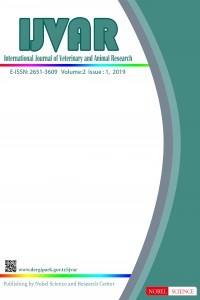Survival and Acid Tolerance of Shigatoxigenic Escherichia coli (STEC) During Frankfurter Sausage Storage
This study was carried out to understand how sausage matrices affect the survival and acid tolerance of STEC O157 and O26. STEC O157 and O26 were inoculated on sausage surface approximately 5 log. After inoculation sausages were vacuum packed and stored at 4°C. Pathogen counts and synthetic gastric fluid (pH 1,5) experiments were conducted on day 0, 15 and 30 of the storage. Three trials were conducted for each pathogen separately. Both serogroups had viable counts on sausage during storage, STEC O26 count decreased about 1log and O157 about 3log during storage. At the end of the storage both O26 and O157 were viable on the sausage surface 4.59 log and 2.54 log respectively. For acid survival experiments pathogen counts were obtained on 30th, 60th and 90th minute of synthetic gastric fluid (SGF) exposure. Our results show that O26 endured acid stress longer than O157 during SGF experiments throughout storage of frankfurters. The results of this study may support the idea that some non-O157 STEC strains might be more resistant to acid stress than O157 STEC but further studies should be conducted before drawing a conclusion.
Anahtar Kelimeler:
Frankfurter, STEC, survival, acid tolerance, synthetic gastric fluid.
___
- Hussein, H.S. 2007. Prevalence and pathogenicity of Shiga toxin-producing Escherichia coli in beef cattle and their products. J. Anim. Sci. 85, E63–E72.
- CDC. 2018. Last Accessed: July 2018. https://www. cdc.gov/ecoli/general/index.html
- USDA, Food Safety and Inspection Service (FSIS). 2010. Detection and isolation of non-O157 Shiga-toxin producing Escherichia coli strains (STEC) from meat products. Microbiological Laboratory Guidebook, version 5B.00. USDA, Food Safety Inspection Service, Washington, DC.
- Özturk F, Halkman A. 2015. Determination of the survival levels of acid-adapted Escherichia coli O157:H7 in sucuk (Turkish-type fermented sausage). Turk J Vet Anim Sci, 39, 485-492.
- Beumer, R.R., de Vries, J. and Rombouts, F.M. (1992) Campylobacter jejuni non-culturable coccoid cells. Int J Food Microbiol 15, 153–163.
- S.A.S. 1999. Statistical analysis system Version 6.1. Cary, Nort Caroline, USA: S.A.S. Institute.
- Bergholz, T., M., Wittam, T., S. 2007.” Variation in acid resistance among enterohaemorrhagic Escherichia coli in a simulated gastric environment”, Journal of Applied Microbiology, 102, 352–362.
- Berry, E.; Barkocy-Gallagher G.A and Siragusa G.R. 2004. Stationary-phase acid resistance and injury of recent bovine Escherichia coli O157 and non-O157 biotype 1 Escherichia coli isolates. J. Food Prot. 67:583–590.
- Miszczycha et al., 2014 S.D. Miszczycha, J. Thévenot, S. Denis, C. Callon, V. Livrelli, M. Alric, et al. Survival of Escherichia coli O26:H11 exceeds that of Escherichia coli O157:H7 as assessed by simulated human digestion of
- Başlangıç: 2018
- Yayıncı: Nobel Bilim ve Araştırma Merkezi Limited
Sayıdaki Diğer Makaleler
Microbiological Attributes of Vacuum Packed Frankfurters Obtained From Local Markets in İzmir
Abdullah DİKİCİ, S. Betül BOZATLI
Yasin DEMIRASLAN, İftar GURBUZ, Omer Gurkan DILEK, Sukru OZUDOGRU, Ozcan OZGEL
A Case of Meningocele in an Akkaraman Lamb
Murat TANRİSEVER, Emine UNSALDİ
S. Betül BOZATLI, Abdullah DİKİCİ
The Effect Of Α-Tocopherol On Ram Semen Freezability In Non-Breeding Season
